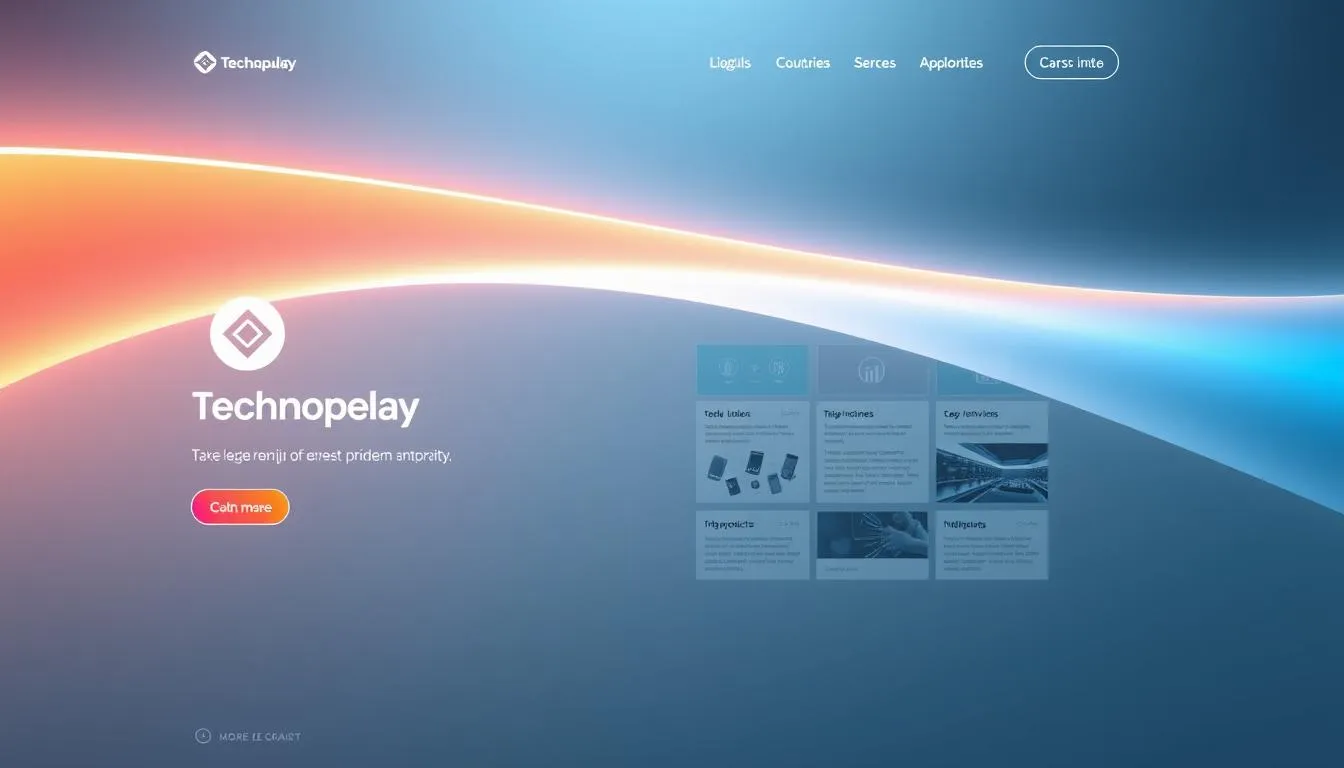Last Updated on: June 19, 2025
In today’s digital landscape, a well-designed tech company website is crucial for establishing a strong online presence. It’s often the first point of contact between a potential customer and the company, making it a vital tool for attracting and retaining clients.
A effective website design not only showcases a company’s products or services but also communicates its values and mission. By incorporating essential elements such as intuitive navigation, responsive design, and engaging content, tech companies can create a website that truly represents their brand.
By focusing on these key aspects, tech companies can enhance their online visibility and drive business growth.
Key Takeaways
- Intuitive navigation is crucial for a tech company website.
- Responsive design ensures a smooth user experience across devices.
- Engaging content is key to capturing and retaining audience interest.
- A well-designed website communicates a company’s values and mission.
- Effective website design drives business growth and enhances online visibility.
The Digital Storefront: Why Your Tech Company’s Website Matters
As the primary interface between a tech company and its audience, the website plays a crucial role in shaping perceptions and driving business success. A tech company’s website is often the first point of contact with potential clients, making it a critical component of the company’s overall marketing strategy.
First Impressions in the Digital Age
In today’s fast-paced digital landscape, first impressions are formed in a matter of seconds. A well-designed website can captivate visitors, while a poorly designed one can drive them away. According to a study, 75% of users judge a company’s credibility based on its website.
The Business Impact of a Well-Designed Website
A well-designed website has a direct impact on business outcomes. It can improve conversion rates, enhance user experience, and increase brand credibility. As noted by a leading web design expert, “A website is not just a digital brochure; it’s a sales tool that can drive revenue and growth.”
What Are the Essential Features of a Tech Company Website?
Tech company websites need to incorporate specific elements to effectively communicate their value proposition. A well-designed website is crucial for establishing credibility and attracting potential clients in the competitive tech industry.
Core Elements That Set Tech Websites Apart
The core elements of a tech company website include clear navigation, responsive design, and prominent calls-to-action. These features ensure that visitors can easily find the information they need and engage with the site effectively.
Additionally, tech websites often incorporate innovative design elements and cutting-edge technologies to showcase their capabilities and stay ahead of the competition.
Industry Standards and Expectations
Meeting industry standards is crucial for a tech company website. This includes adhering to best practices for security, such as HTTPS encryption, and ensuring compliance with accessibility guidelines. By doing so, tech companies can build trust with their audience and demonstrate their commitment to quality.
Furthermore, tech company websites are expected to have regular updates and fresh content, which helps in maintaining visitor engagement and improving search engine rankings.
User-Centric Design: Creating Intuitive Navigation
User-centric design is not just a buzzword; it’s a critical approach to creating tech company websites that offer seamless navigation. By prioritizing the user’s needs and behaviors, tech companies can develop websites that are both visually appealing and highly functional.
Information Architecture Best Practices
A well-structured information architecture is the backbone of intuitive navigation. It involves organizing content in a logical and coherent manner, making it easier for users to find what they’re looking for. Clear categorization and minimal cognitive load are key principles to follow.
Navigation Patterns That Convert
Effective navigation patterns play a crucial role in enhancing user experience and driving conversions. Tech companies should adopt navigation patterns that are familiar to their users, such as the hamburger menu for mobile devices or breadcrumb navigation for complex sites. These patterns help in reducing friction and improving the overall user journey.
Accessibility Considerations for Tech Websites
Ensuring that a website is accessible to all users, including those with disabilities, is not only a legal requirement but also a moral imperative. Tech companies should adhere to Web Content Accessibility Guidelines (WCAG) to make their websites more inclusive. This includes providing alternative text for images and ensuring that the site can be navigated using a keyboard.
Visual Identity and Branding Elements
In the digital age, a tech company’s website is often the first point of contact with potential customers, making its visual identity paramount. A strong visual identity not only captures the essence of the brand but also communicates its values and mission at a glance.
Color Psychology for Tech Companies
The choice of colors for a tech company website is not just about aesthetics; it’s about evoking the right emotions and conveying the brand’s personality. For instance, blue is often associated with trust and stability, making it a popular choice for tech companies. Color psychology plays a crucial role in creating an immediate connection with the audience.
Typography and Readability
Typography is another critical element of visual identity. The right font can enhance readability and reinforce the brand’s character. Tech companies often opt for clean, sans-serif fonts to convey modernity and professionalism. Ensuring readability across various devices is essential for a seamless user experience.
Imagery and Visual Storytelling
Imagery and visual storytelling are powerful tools for tech companies to convey complex ideas simply and engagingly. Using high-quality images, infographics, and videos can help illustrate the company’s products and services, making them more accessible to a broader audience. A well-crafted visual narrative can significantly enhance the brand’s appeal.
By carefully balancing color psychology, typography, and imagery, tech companies can create a compelling visual identity that resonates with their target audience and sets them apart in the competitive tech landscape.
Content Strategy for Tech Companies
A well-crafted content strategy is crucial for tech companies to effectively communicate their value proposition. In the tech industry, complex solutions and innovative products require a clear and concise narrative to resonate with the target audience.
Communicating Complex Solutions Simply
Tech companies often deal with intricate products or services that can be challenging for potential customers to understand. A successful content strategy simplifies these complex solutions, making them accessible to a broader audience. This involves using clear language, avoiding jargon, and focusing on the benefits rather than just the features.
Showcasing Technical Expertise
Establishing technical expertise is vital for building trust with potential customers. Through thought leadership content, such as in-depth articles, webinars, and speaking engagements, tech companies can demonstrate their knowledge and capabilities. This not only helps in differentiating themselves from competitors but also in attracting high-quality leads.
Content Types That Engage Tech Audiences
Various content types can be used to engage tech audiences, including:
- Blog posts that address industry trends and challenges
- Case studies that highlight successful implementations
- Whitepapers that provide detailed insights into complex topics
Case Studies and Success Stories
Case studies are particularly effective in showcasing how a tech company’s product or service has helped other businesses achieve their goals. They provide tangible evidence of the company’s capabilities and the impact of their solutions.
Technical Whitepapers and Resources
Technical whitepapers offer a detailed examination of specific topics, demonstrating a company’s thought leadership and expertise. These resources are highly valued by tech audiences seeking in-depth information.
By incorporating these content types into their strategy, tech companies can effectively engage their audience, build credibility, and drive business growth.
Product and Service Showcases
The way tech companies showcase their products and services can significantly impact their conversion rates and customer engagement. An effective showcase not only highlights the features and benefits of their offerings but also resonates with their target audience’s needs and preferences.
Effective Product Demonstrations
Product demonstrations are a powerful way to give potential customers a hands-on experience with a product or service. By showcasing how a product works and its benefits, tech companies can build interest and trust. Interactive demos allow users to explore features at their own pace, increasing the likelihood of conversion.
Feature Comparison Tools
Feature comparison tools enable potential customers to evaluate different products or services side by side. This transparency helps in making informed decisions. By highlighting the unique selling points and advantages of their offerings, tech companies can differentiate themselves from competitors. Comparison charts are particularly effective for this purpose.
Testimonials and Social Proof
Testimonials from satisfied customers serve as social proof, building credibility and trust with potential customers. Highlighting success stories and case studies can demonstrate the real-world value of a product or service.
“The implementation of their software solution significantly improved our operational efficiency.”
Such endorsements can be a compelling factor in a customer’s decision-making process.
By incorporating these elements, tech companies can create a robust product and service showcase that not only attracts potential customers but also converts them into loyal clients.
Performance Optimization: Speed and Responsiveness
As users increasingly demand seamless online experiences, optimizing website performance has become a top priority for tech companies. A well-optimized website not only improves user satisfaction but also contributes to better search engine rankings.
Page Load Time Optimization
Page load time is a critical factor in user experience and SEO. Optimizing images, leveraging browser caching, and minifying CSS and JavaScript files are effective strategies to reduce load times. Ensuring that your website loads within 3 seconds can significantly reduce bounce rates.
Mobile Responsiveness and Adaptive Design
With the majority of users accessing websites through mobile devices, mobile responsiveness is no longer optional. Implementing adaptive design ensures that your website provides a seamless experience across various screen sizes and devices.
Testing Across Devices and Browsers
Thorough testing is essential to ensure compatibility. Use tools like BrowserStack to test your website across
- different browsers
- various devices
- multiple operating systems
Progressive Web App Capabilities
Progressive Web Apps (PWAs) offer a native app-like experience. They provide offline capabilities, push notifications, and home screen installation, enhancing user engagement and retention.
Security Features and Trust Signals
A secure website is no longer a luxury, but a necessity for tech businesses. As users increasingly rely on digital platforms, trust becomes a critical factor in their decision-making process.
Essential Security Implementations
To establish a secure online presence, tech companies must implement robust security measures. This includes SSL/TLS encryption to protect data in transit and regular security updates to patch vulnerabilities. Implementing two-factor authentication adds an extra layer of security, making it harder for unauthorized users to gain access.
Building Trust with Privacy-Conscious Users
Building trust goes beyond just security; it’s also about respecting user privacy. Transparency is key.
GDPR and Data Protection Compliance
For tech companies operating in or with the European Union, GDPR compliance is not just a legal requirement but a trust signal. Clearly outlining data collection practices and user rights enhances transparency.
Security Badges and Certifications
Displaying security badges and certifications can significantly boost user confidence. These visual cues signal that a website adheres to certain security standards, making it a safer environment for users.
By prioritizing security features and trust signals, tech companies can create a safer, more trustworthy online environment.
Lead Generation and Conversion Elements
Effective lead generation is crucial for tech companies to drive growth and stay competitive in the digital landscape. A well-crafted website with strategic elements can significantly enhance lead generation and conversion rates.
Strategic Call-to-Action Placement
The placement of call-to-actions (CTAs) is a critical factor in converting visitors into leads. CTAs should be prominently displayed on key pages, such as the homepage, product pages, and blog posts. Using action-oriented language like “Get Started” or “Sign Up Now” can encourage visitors to take the desired action.
Contact Forms and Demo Requests
Contact forms and demo requests are essential tools for capturing lead information. Simplifying the form-filling process by reducing the number of required fields can increase form submissions. Offering demo requests or free trials can also entice potential customers to engage further with your product or service.
Pricing Strategy and Presentation
A clear and transparent pricing strategy is vital for converting leads into customers. Pricing tables should be easy to understand, with clear distinctions between different plans or packages. Highlighting the value proposition of each plan can help potential customers make informed decisions.
Customer Support and Self-Service Options
The modern tech consumer expects more than just a product or service; they demand seamless support and intuitive self-service options. In today’s competitive tech landscape, providing effective customer support and self-service features is crucial for building trust and ensuring customer satisfaction.
Live Chat and Support Integrations
Integrating live chat functionality into a tech company website can significantly enhance customer support. It allows for real-time communication, enabling customers to get immediate assistance with their queries. When implementing live chat, it’s essential to ensure that it’s user-friendly and seamlessly integrated with other support tools.
Knowledge Base and Documentation
A comprehensive knowledge base and detailed documentation are vital self-service options that empower customers to find answers independently. This not only reduces the workload on support teams but also enhances the user experience by providing 24/7 access to information. Organizing content in a logical and easily navigable manner is key to the success of these resources.
Community Forums and User Engagement
Community forums offer a platform for users to engage with each other, share experiences, and find solutions to common problems. By fostering a sense of community, tech companies can build loyalty and encourage user-generated content. Moderating these forums effectively is crucial to maintaining a positive and helpful environment.
Conclusion: Building a Website That Grows With Your Tech Company
Crafting a powerful tech company website is crucial for establishing a strong online presence. As your business evolves, your website should adapt to meet the changing needs of your audience.
A well-designed website is not just a digital storefront; it’s a dynamic platform that showcases your tech company’s capabilities and values. By incorporating essential elements such as user-centric design, visual identity, and content strategy, you can create a website that resonates with your target audience.
Effective website development is an ongoing process that requires continuous optimization and improvement. As your tech company grows, your website should be able to scale and adapt to new challenges and opportunities. By prioritizing website development and staying focused on your audience’s needs, you can build a website that drives long-term success for your tech company.
FAQ
What are the key elements of a well-designed tech company website?
A well-designed tech company website should have a clear navigation, a strong visual identity, and a user-centric design that provides an intuitive user experience. It should also include essential features such as product and service showcases, customer support options, and lead generation elements.
How does a tech company website influence first impressions and business outcomes?
A tech company website is often the first point of contact between a potential customer and the company, making it crucial for creating a good first impression. A well-designed website can establish credibility, build trust, and drive business outcomes by providing a clear and concise message about the company’s products and services.
What is the importance of mobile responsiveness in tech company websites?
Mobile responsiveness is critical in tech company websites as it ensures that the website is accessible and usable across various devices and screen sizes. This is essential for providing a good user experience and for search engine optimization (SEO).
How can tech companies showcase their products and services effectively on their website?
Tech companies can showcase their products and services effectively by using clear and concise language, high-quality imagery, and interactive elements such as demos and trials. They can also use feature comparison tools and customer testimonials to build credibility and trust.
What security features should tech companies implement on their website?
Tech companies should implement essential security features such as HTTPS, firewall protection, and regular software updates to protect user data and prevent cyber threats. They should also display security badges and certifications to build trust with users.
How can tech companies optimize their website for lead generation and conversion?
Tech companies can optimize their website for lead generation and conversion by using strategic call-to-action placement, clear and concise messaging, and user-friendly contact forms. They can also use pricing strategy and presentation to drive conversions.
What is the role of content strategy in tech company websites?
A content strategy is crucial in tech company websites as it helps to communicate complex solutions simply, showcase technical expertise, and engage the audience through various content types. It should include a mix of content such as case studies, technical whitepapers, and blog posts.
How can tech companies ensure that their website is accessible to all users?
Tech companies can ensure that their website is accessible to all users by following accessibility guidelines and best practices, such as providing alternative text for images, using clear and consistent navigation, and ensuring that the website is usable on various devices and browsers.
What is the importance of page load time optimization in tech company websites?
Page load time optimization is critical in tech company websites as it can significantly impact user experience and search engine rankings. A slow-loading website can lead to high bounce rates and lost conversions.
How can tech companies build trust with their users through their website?
Tech companies can build trust with their users by displaying trust signals such as security badges and certifications, providing clear and concise messaging, and showcasing customer testimonials and reviews. They can also ensure that their website is transparent and easy to navigate.




